
That we live in a litigious society is evident to anyone who has spent even a little time in front of the television, where commercials touting the services of personal injury or product failure attorneys are pervasive reminders about how precarious life can be. Consumers have become ever more demanding in their expectations of what products should deliver—an attitude that has led to some pretty wild claims about product attributes from manufacturers hoping to stand out in crowded, competitive markets. Since oversight can be fairly lax for certain product categories, many of these assertions go untested, leaving consumers in the dark (and exposing them to potential risk) as to actual, measurable product performance.
This is not the case with personal protective equipment (PPE) and occupational gear/equipment, nor for the fabrics and textiles they incorporate. For these products, it’s not enough to merely state a particular product does this or that: performance must be proven.
The fabric supplier
Prestige Impex Inc., located in Cumming, Ga., supplies woven industrial textiles (primarily from cotton fibers) to manufacturers in industries like safety products, promotional, home furnishing, camping and hunting, filtration and other markets. Prestige also does textile conversions and supplies dyed and finished fabrics, says Steve Qmar, director of sales.
The company specializes in supplying sturdy, heavyweight cotton canvas fabrics, much of which goes into making safety products. The list includes canvas tool buckets, designed to be extremely abrasion- and cut-resistant; and safety harness bags, multipurpose bags worn like a belt and used to carry tools and items like goggles, vests and flashlights.
“Our customers have to ensure their gear is top-notch,” says Qmar. “For example, the worker may be carrying heavy tools in these canvas bags. If our fabric isn’t up to the mark, chances are high that the bag will rupture and bust open—both unsafe and unproductive.”
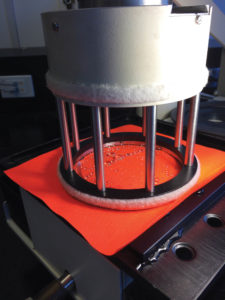
Depending on end user requirements, Prestige woven fabrics are tested for weight, thread count, thickness, tensile and tear strengths, air permeability and more. Only fabrics passing ASTM and AATCC standards (Prestige also tests for color rub-off, wash-fastness and other standards) are sent to manufacturers.
“When making a tool bag, the ability to hold the weight of the tools is associated with the tensile strength of the product, so usually that’s tested,” Qmar notes. “But in a filtration bag, the air-permeability—a measure of the porosity of the material—is more important. When it comes to a canvas belt that runs in loops, the thickness of the fabric is one of the critical points checked first.”
Textile testing provides the foundation for product performance. “By laying out the basic guidelines and setting up the tolerance limits, it’s fairly easy to predict how a product will perform under certain conditions,” says Qmar. “This enables manufacturers to write product safety sheets and to know what they should, or shouldn’t do, with the supplied products.”
The fabric finisher
Located in Hickory, N.C., TSG Finishing is a common finisher, adding a variety of performance characteristics to different textiles products, says Bud Styles, director of operations/sales. The finishes are applied using mechanical or chemical treatments.
“Our two primary areas are the military (uniforms) and medical (drapes and gowns),” Styles says. “We do treatments for other specialty applications such as sportswear, workwear, evaporative management, odor control and water repellency. The finishes are primarily applied to synthetic blends but also to a good bit of wool and cotton.”
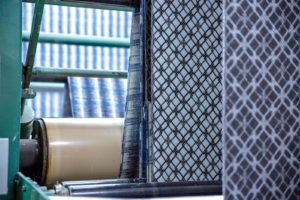
The company’s top performance categories are water and stain repellency with breathability—“a requirement of most industries that crosses over many markets,” Styles says. But TSG also applies finishes and tests for seam slip/tear resistance, shrink resistance, flame retardancy, abrasion and pilling resistance, antimicrobial abilities and odor control, barrier properties and static dissipation. The company does internal testing focusing on quality control (“These are versions of the tests performed by the labs,” says Styles), forwarding the material to an outside lab if needed for certification purposes or market requirements.
Product innovation and manufacturers’ desire to meet consumer needs (and besting their competitors) is fueling the demand for performance testing, says Styles.
“Our customers are focused on their markets and are listening to market demands for new products,” he says. “If you can differentiate yourself from the rest of the market by meeting one more customer need, then success is in front of you. And we’re constantly looking for new and crossover technologies that will help our customers differentiate their offerings.”
The instrument provider
Thermetrics LLC designs and manufactures a broad spectrum of advanced test instruments used for measuring and evaluating the thermal characteristics of textiles, garments and protective clothing, says
Dave Heiss, sales and marketing director for the Seattle, Wash.-based company. Thermetrics also measures and evaluates the “dynamic environments” of vehicles, aircraft and home and office interiors. The line of thermal manikins, guarded hotplates and flame test systems can be found throughout certified testing agencies, textile research universities and government labs worldwide. Their equipment is designed to support an extensive range of test methods, including multiple ASTM, NFPA and ISO standards.
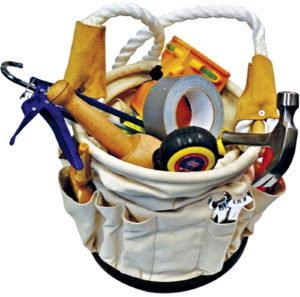
“One driver of test selection is often the amount of historical test data a company may have,” says Heiss, explaining what leads a company to select certain tests over others. “For existing products, it’s important to periodically correlate present performance with past to make sure there has been no decline in the level of protection a garment provides. And, if garment materials or construction has changed, it’s even more important to assess the new test data with historical benchmarks.”
Heiss says manufacturers have three areas of focus when it comes to protective gear and garments: comfort, protection and meeting the required government standards.
“Each leads to a series of tests that help define the performance of a given piece of protective gear,” he says. “A minimalist approach is simply meeting the standards, but today’s customer is looking for more than that. They want to know on a more personal level how a garment is going to perform for them.”
Comfort has become a particular concern. For example, over the past several years, moisture management is playing an increasingly important role in the development of new textiles as well as in garment design and construction methods, Heiss says, since the ability to dissipate moisture in the face of thermal stress plays an integral role in the comfort performance of protective garments. Consequently, as textiles become more “complex and multifunctional,” moisture management will continue to be an important test criterion. But there are many testing options.
“[These] range from tests of a fabric’s physical properties (tear strength, colorfastness, shrinkage, etc.) to inherent performance properties such as moisture and heat resistance,” he says. “Test standards exist for all these characteristics, and while many tests are required due to government safety regulations, others can be highly informative and useful for marketing purposes.
“Therefore, textile testing becomes not just a data point that check marks a box; it becomes the supporting framework for a story of interaction between the user and the garment,” Heiss continues. “Companies prepared to tell that story will win in today’s marketplace.”
The testing facilities
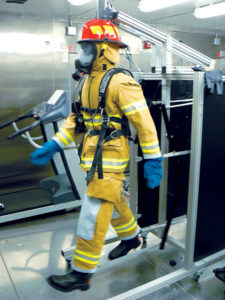
Intertek provides Total Quality Assurance (TQA) to industries worldwide via a network of more than 1,000 laboratories and offices in more than 100 countries, says Jason Allen, technical advisor. Headquartered in London, U.K., Intertek’s PPE lab is located in Cortland, N.Y. The lab tests PPE worn by people working in numerous occupations and industries such as medical and construction work, firefighters and EMS workers, hazmat teams, law enforcement, athletes, bomb technicians and others. Among the items tested are helmets, gowns, fall-protection products, footwear, boots, gloves, hazmat suits, eyewear and protective garments.
“We test 1,000-plus methods ranging from thread tests to full ensemble evaluations,” says Allen. “Some of the tests include cut resistance, abrasion resistance, chemical permeation/penetration, viral resistance, tensile properties and breathability.”
A variety of materials undergo testing and evaluation. These include, for example, nonwovens and thin-film-based and semipermeable laminates, evaluated for chemical and viral resistance; and coated and/or aramid-based materials, for cut and abrasion resistance (“We also see plastics, wovens and all other types of materials used within PPE,” Allen says).
Certain tests have become more in demand than others, spikes caused by world events, catastrophes or the far more ordinary changes in standards and regulators. For example, says Allen, the aftermath of 9/11 saw an increase in requests for tests primarily focused on cut- and abrasion-resistance used on materials and items destined for rescue and recovery.
“And, as the anti-terrorism efforts increased post-9/11, there were also significant requests for the evaluation of a material’s permeation resistance against chemicals such as warfare agents and toxic industrial chemicals like ammonia, chlorine, dimethyl sulfate, acrolein and acrylonitrile,” Allen says. “Due to the length of time garments made from these materials are often worn, this testing was also coupled with an evaluation of user comfort using tests such as Total Heat Loss (THL).”
Due to the Ebola outbreak, the lab conducted viral penetration evaluations on a “significant number of materials and products,” says Allen. OSHA changes in focus—for example, the agency has recently placed greater emphasis on fall protection—also accelerate the demand for specific types of tests.
CTT Group is a technology transfer center specializing in the research, development and testing of technical textiles, advanced textile-based materials and geosynthetics. Located in Saint-Hyacinthe, Quebec, Canada, the company offers a range of services, from performance and characterization analysis for testing and certification purposes, through research and development to advanced prototyping for new applications, says Valerio Izquierdo, vice president, Textile Laboratories and Expertise. Like Intertek, CTT conducts performance testing (to various standards) on a wide variety of products in the PPE category, with the kinds of evaluations performed dependent on the occupational activity.
“[For example], workers potentially exposed to hydrocarbon flash fire—for instance oil and gas extraction—usually have coveralls or protective gear that are compliant to specifications covering various risks,” says Izquierdo. “An exposure to dry heat is performed on the fabrics to limit the risk of intense shrinkage [and materials melting]. The flame resistance is also required. Materials resistance to a flash fire is [also] measured.”
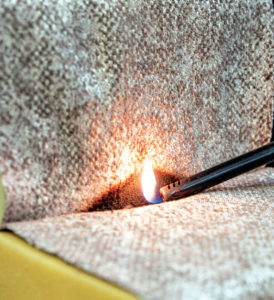
Or consider PPE for firefighters. In addition to the normal evaluations for flammability and shrinkage/melting with exposure to heat, parameters evaluated include resistance to penetration by certain chemicals, like battery acid, gasoline, aqueous film-forming foam (among others); TPP; water penetration; THL; and resistance to penetration from micro-particulates.
In addition to ballistic vest requirements, protective apparel for law enforcement may require evaluation to prevent penetration of liquids like gas or battery acid, breathability/moisture management (for comfort) and resistance to water penetration or water repellency, says Izquierdo. Items directed to the medical arena, such as surgical drapes and gowns, are evaluated for water penetration, penetration to synthetic blood and viral penetration resistance.
“Even professional hockey players or other athletes, such as speed skaters, have specific needs; for example, cut resistance,” he says. “We actually just published a book, Advanced Characterization and Testing of Textiles, which covers the variety of test standards and methods.”
Textile testing allows for the objective performance evaluation of a given material, since the tests are based on standard test methods available through accepted entities such as ASTM, ISO and CGSB, says Izquierdo. According to Allen, testing can also save manufacturers money.
“Oftentimes, [testing] can help sort out an end product’s likelihood of success prior to the creation of expensive prototypes,” he explains. “To help the process run smoothly, we suggest an open dialogue with our engineers to be sure we’re evaluating the product in the nearest configuration possible to end-use at that stage in the product’s development.”
Pamela Mills-Senn is a freelance writer based in Long Beach, Calif.
 TEXTILES.ORG
TEXTILES.ORG


